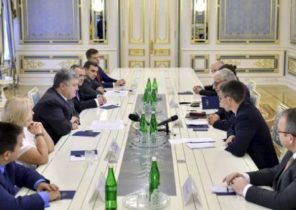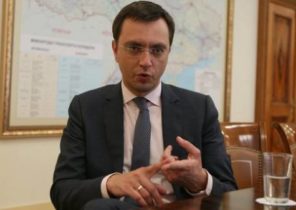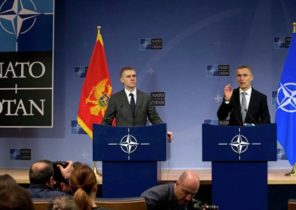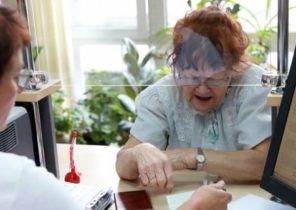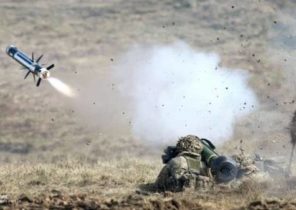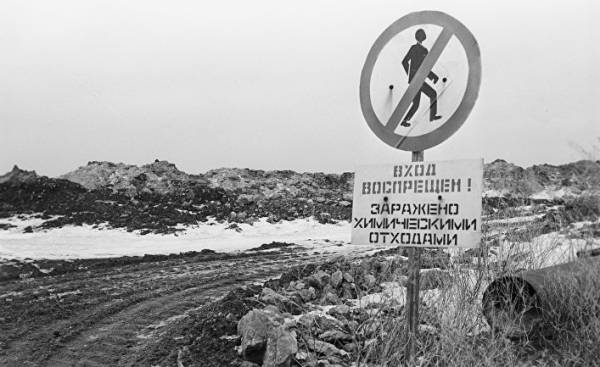
During the cold war, her hometown, to the outside world did not exist. The enrichment of uranium for the Soviet nuclear weapons were conducted in secret. Only Russian was allowed to be in sillamäe. Like his father Svetlana Mukhina. Now she lives in Russia’s shadow, dangerous border between West and East.
We in the County of IDA-Viru County in northeastern Estonia. The vast majority of people here are Russian, on whichever side of the border river Narva we are. Narva powerful stream flowing from lake Peipus (lake Peipus) in Narva lip, part of the Gulf of Finland.
It was here that Charles XII during a snowstorm won a historic battle against the Russian army, which laid siege to the fortress of Narva in 1700. A powerful defensive structure still stands there, on the Estonian side of the city, as a witness of those events.
In the courtyard of the fortress stands the statue of Lenin in the coat. He stretches out his hand to the side of Russia and Moscow.
On the opposite side, on top of a medieval fortress in Ivangorod flies a Russian flag. Strictly protected and partially covered bridge connects the fortress. People walk or move across the river by car, most of them carry bags filled with inexpensive products.
“In Ivangorod cheaper and you can relax,” says the young man. He, along with two friends shows the packets with vodka, beer and cigarettes.
The group is inhomogeneous
The Russian-speaking population here in Estonia did not constitute a homogeneous group, and their roots can be and Russian, Belarusian and Ukrainian. Many consider it important to his Russian origins, watching Russian news channels and read Russian Newspapers. Naturally, they, like most of us, sensitive to news, propaganda and misinformation.
But we don’t meet anyone who would like to move to Russia, or even less — to be “liberated.” In Estonia, the standard of living is higher. For the vast majority of the benefits of living here mean so much more.
“It is important to remember history. But I like living here in Estonia. Why do I have to request a citizenship? I am Russian and was born here, it should be my natural right. We don’t buy the air we breathe,” — says Svetlana Mukhina.
It shows the document is gray. It says: “ALIENS PASSPORT”. The passport of the foreigner.
The citizens of Estonia, a blue passport, they can vote in parliamentary elections. Svetlana had no such right. She speaks Estonian and cope language tests, if you apply for, but she won’t. But she can travel around the EU and work there.
Svetlana is 29-year-old son, who lives separately, and she left to live in the apartment mother and father in sillamäe, the previously closed village about 20 kilometres West of Narva. She was born in 1958 and grew up in this four-storey off-white building in the district, which is reminiscent of the accelerated program of housing construction, which in Sweden was carried out in 60-ies.
Good relations with neighbors
She lives near the sea, where she often swims in the summer, looking at the Gulf of Finland in the North. She has a good relationship with the neighbors. The Laundry hanging to dry on a gray, abandoned the Playground, while on the street a strong frost.
“I remember my childhood a long and happy”, — says Svetlana.
She pulls the hat deeper over her ears and says:
“It was a closed city, but everything in it was happy. Everything was in close relations with each other like a family. My father loved this city. I love him too”.
Her father, a Soviet army officer, was stationed here in 1948. He worked at a military facility, which also produces uranium from local shale and imported uranium for the Soviet nuclear program.
He served there until, until, according to his daughter, a doctor in St. Petersburg suggested that he stop doing this work. It was in the 50-ies, when Nikita Khrushchev came to power in Russia and did away with the Stalinist legacy.
Svetlana went to school here, then studied to be a nurse and worked for two years in Russia. Due to health problems she had to leave work, and instead she began to study at University in Lithuania. Now she earns a living writing translations.
She was in Sweden. Went there on the ferry “Estonia”. 10 days after a ferry sank in the Baltic sea. It wakes up in her dark thoughts but travel and new experiences still inspire her. And every time she wants to go back to Simikot.
“There are drawbacks, of course, but this is my house”.
Svetlana lived in a part of Estonia, where unemployment is above everything, with all the ensuing consequences for people’s lives, their well-being and faith in the future. But, being Russian, she does not feel a stranger.
“I can speak to all, and many younger Russians know English. I believe they have a future in Estonia, and I think that will open new opportunities in order to enable them to live and work where they want”.
According to the picture painted by the Russian and Western media, the tension grows, the threat and the likelihood of conflict becoming more real, and especially in that part of Europe, where she lives, but the truth lies somewhere in between, says Svetlana.
“I’m trying to find a middle ground. I’m not afraid, but anything can happen. They say that only mad people have no fear. Sometimes I get so scared when I repeatedly hear the same arguments, but it doesn’t happen every day.”
Buildings in the Stalinist style
House Svetlana is located within walking distance of the magnificent buildings and boulevards, built in the Stalinist style in the late 40-ies. German prisoners were used as slaves in their construction, says Svetlana, while we wander around a nearly empty snow-covered streets this frosty day.
A beautifully-renovated cultural center on white walls there are bas-reliefs of Marx and Lenin, near the stage in a huge hall with Seating for over 400 spectators. The sickle and hammer depicted in the stucco of the ceiling.
In the basement, hidden behind a green metal door, is an old bomb shelter with air purifying unit and the gas masks, and hidden creeping claustrophobia. There is also a small Museum of the Soviet era.
The two busts of Lenin on their necks tied red scarves, like the members of the famous bull race in Pamplona, Spain, held every summer. A portrait of Stalin, oil occupies the wall above the typical for that era writing Desk with green felt cloth and a bakelite disk phone.
Nearby chemical and nuclear facility, Factory number seven, where the father of Svetlana, and which for a long time was not on the map, and he appeared only when Estonia regained independence in 1991.
Leak dust of radioactive waste in the factory area, which is regarded as one of the most dangerous threats to the ecology of Europe. Work on the deactivation took place before 2008.
Be here now is safe, but control is always carried out with the help of the dosimeter reported dose of radiation is exposed to everyone on this site.
“I was never afraid. In any place you so much do not watch,” says Jane Paju (Paju Jane), member of the Directorate of factories.
She says that today Neo Performance Materials produces rare earth metals, metallic materials and magnetic dust. Abroad the demand for it is great. The port was expanded, and the canadian owners are willing to invest in sillamäe and on.
“The number of people that have ever worked here, this is from five to six thousand. Now there are about 500 employees, all Russian with the exception of ten Estonians. But over the years they finish the work, and attracting new qualified personnel in sillamäe became a big issue,” says Jane Paju.
In the long run this jeopardizes their activities, and to the locality in which he lives less than 15 000 people, the closure of the factory would be a serious blow.
The building of the Eastern bloc in a grey-brown
We are back in Narva and we pass by the grey, beige and brown buildings of the Eastern bloc, diluted with couple of modern shopping centres known to us, the Swedes, the names of the shops. Before returning to the hotel, we stroll under a little snow to the river and border control. In one of the bastions of the city, we are introduced to violet Galkina, 22, and Elizabeth Kruglikova, 21.
“We live in Saint-Petersburg and came here to visit friends for four days. Elizabeth lives in Estonia and is now studying. I work in a restaurant,” says Violetta.
They are taking pictures on phones and laughing, in the early dusk make selfi on the background of the river, bridge and Russian fortress.
We are watching traffic in the distance, and cold grey haze dissolves the outlines of this historic venue. Here, at the outer Eastern border of the EU and NATO, to unpredictable Russia, which is its impressive statements with bold action and military operations and exercises irritates and puts pressure on the Western defense Alliance.
In response, many soldiers and heavy weapons moving to the East to repel the Russian President Vladimir Putin. The goal is to the annexation of Crimea and the current war in Eastern Ukraine is not repeated here.
However, many experts have warned of the growth-spiral arms, and very easily can happen if someone loses control, by mistake or intentionally.
Large Russian minority
In the Baltic sea a very large Russian minority. As history shows, for Russia this may be the reason for the action. One thing is clear: without membership in NATO and the EU Estonia, with just over 1.3 million inhabitants, of which one quarter — Russian, would be easy prey.
On the difficult relations between Russia and the West a lot of thought Valery Loginov, when I lived in Narva, but now it doesn’t.
“I’m more concerned with Brakcet and where to go if I get put up,” says 22-year-old girl.
She sits at a table in Fama shopping centre with her sister Katrina Smirnova, 15 years. This is their last day spent together before Valeria will go back to London.
While Catherine can’t imagine to move out of here — she wants to stay and become a police officer — her older sister was plagued by doubts about what will happen after the Brits leave the EU.
“I live in the UK for almost four years. I study chemistry in Cambridge in the direction, which is not here. I had to move. Make about it the decision was easy. I visit family in Narva about twice a year.”
To the question, would she move back home and work here, she answers hesitantly:
“It’s hard to say. Unemployment is high, and for me there’s no work, I think it would be better to take the family with you.”
Their parents are Russian. Dad has an alien passport and my mother Estonian citizenship, she coped with the tests, says Valeria. This means that the mother and the eldest daughter has to obtain a visa to come to Russia.
Half Russian, half Estonian
“I grew up on Russian culture and celebrate Russian holidays,” she says, “I speak Russian with my family and friends. But I’m Estonian, I was born here and speak Estonian. I feel I am half Russian and half Estonian.
Estonian citizenship helps Valerie to go to Europe and study there. It is for her plays a big role. But she doesn’t know what to expect in the coming years.
“Look,” she says.
Younggren Anders (Anders Ljunggren), the Swedish Ambassador in Tallinn. If the unimaginable happens, and Estonians leave alone their trust in NATO and the EU will be lost forever, he says.
“They are very well feel that if there is a threat, it is aimed at the whole of the EU and NATO. Can’t say that they’re wrong. Well-organized cooperation within Europe and NATO is very important for Estonia.”
Ten years ago, many Russians in Estonia feel different. But today there was deep integration, says Anders Younggren.
“Those who do not have Estonian citizenship, less. The younger generation is fluent in Estonian”.
There is a political will and desire has to deepen integration, says Anders Younggren.
“In the Narva region is constructed with special language and cultural center. Now there is a discussion about how to allocate more public administration. Now also have confidence in the fact that the majority of Russian-speaking population in Estonia feels good.
But there is a large group that still receives almost all of its information exclusively from Russia.
“They live in a cocoon, which is mostly controlled from the Kremlin. That is why Estonian government is developing a Russian-language TV channels and programs,” says Anders Younggren.
Compared to Russia, Estonia has a very positive economic development. It says that all will favorably develop in the future.
“It is difficult to assume that in the future something will change. What causes issues is population growth. In 1992, in Estonia there were some 1.5 million people, and today there are 1.3 million. There are pessimistic predictions that the working population will shrink.”
A serious problem
For politicians this is a serious task to cope with the economy and at the same time reduce emigration with competitive salaries and social support like childcare and affordable housing, says Anders Younggren.
“But I am very optimistic,” says he, “Before the second world war, Estonia’s GDP per capita was on the same level as in Finland, almost the same as in Sweden. I think it can come again, if they are able to maintain a state of law, democracy, market economy and, of course, the world.
Estonia became the best in Europe in the framework of the International program on assessment of educational achievements of students (PISA). Estonians are internationally oriented and are leaders in the field of IT. They have the best preconditions for a well-developing prosperity of the country, says Anders Younggren.
“I think few people want to change something,” he says.
The proportion of residents born overseas, by and large the same as in Sweden. Industry and trade would not hurt the immigration.
“Some enterprises would like to expand but can’t because of the lack of manpower. I believe the majority in the Estonian Parliament wants to advocate for increased openness.”
It was and Svetlana Mukhina in sillamäe:
“People can speak the same language and still not understand each other. And I want to maintain friendly relations with all, regardless of nationality and Estonian roots,” she says.
She goes every day to the library for a special reason:
“Newspapers is for me like meditation. It calms me”.
